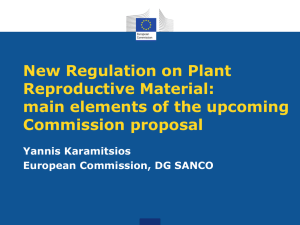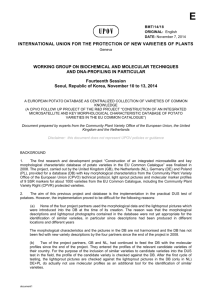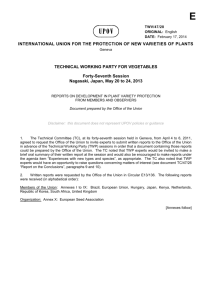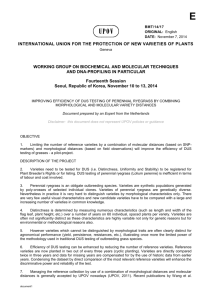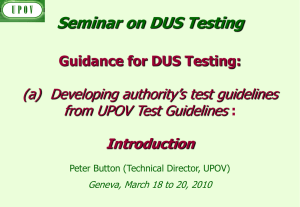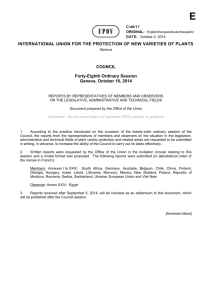E - UPOV
advertisement
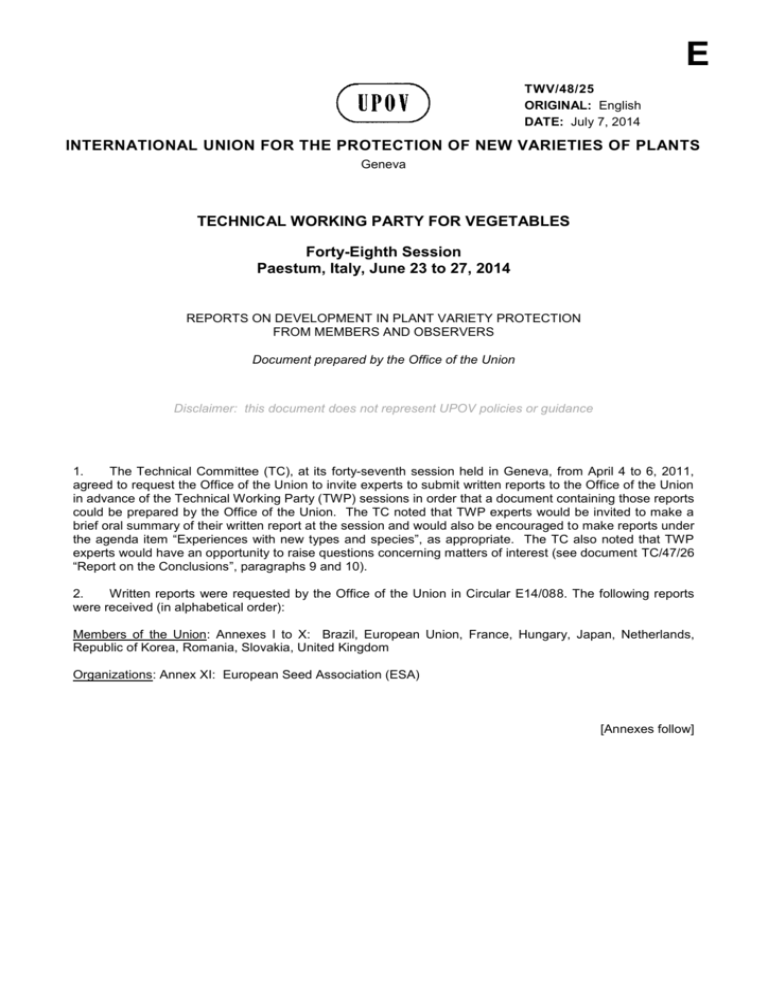
E TWV/48/25 ORIGINAL: English DATE: July 7, 2014 INTERNATIONAL UNION FOR THE PROTECTION OF NEW VARIETIES OF PLANTS Geneva TECHNICAL WORKING PARTY FOR VEGETABLES Forty-Eighth Session Paestum, Italy, June 23 to 27, 2014 REPORTS ON DEVELOPMENT IN PLANT VARIETY PROTECTION FROM MEMBERS AND OBSERVERS Document prepared by the Office of the Union Disclaimer: this document does not represent UPOV policies or guidance 1. The Technical Committee (TC), at its forty-seventh session held in Geneva, from April 4 to 6, 2011, agreed to request the Office of the Union to invite experts to submit written reports to the Office of the Union in advance of the Technical Working Party (TWP) sessions in order that a document containing those reports could be prepared by the Office of the Union. The TC noted that TWP experts would be invited to make a brief oral summary of their written report at the session and would also be encouraged to make reports under the agenda item “Experiences with new types and species”, as appropriate. The TC also noted that TWP experts would have an opportunity to raise questions concerning matters of interest (see document TC/47/26 “Report on the Conclusions”, paragraphs 9 and 10). 2. Written reports were requested by the Office of the Union in Circular E14/088. The following reports were received (in alphabetical order): Members of the Union: Annexes I to X: Brazil, European Union, France, Hungary, Japan, Netherlands, Republic of Korea, Romania, Slovakia, United Kingdom Organizations: Annex XI: European Seed Association (ESA) [Annexes follow] TWV/48/25 ANNEX I BRAZIL 1. The National Plant Variety Protection Service (SNPC) on the Ministry of Agriculture, Livestock and Food Supply (MAPA), is the national authority for the examination of applications and for granting Plant Breeder’s Rights in Brazil. 2. In 2013, SNPC received 326 applications: agricultural crops (177), ornamentals (50), vegetables (35), fruit crops (28), forest trees (23) and forage crops (13). 3. Those 35 applications were for the following: Lactuca sativa (13), Solanum lycopersicum (10), Daucus carota (03), Cucumis melo (03), Pisum sativum (02), Abelmoschus esculentus (02), Citrullus lanatus (01) and Capsicum (01). 4. Applications were filed from nationals of: Brazil (19), Netherlands (13), United States of America (02), and France/Netherlands (01). 5. Five (05) titles were granted to the following species: Lactuca sativa (02), Solanum lycopersicum (02), Cucumis melo (01), 6. Those titles were granted to applicants from: Brazil (03), Netherlands (02). 7. Up to June 15th, 2014, SNPC received 124 applications, 9 of them to vegetables; and granted 87 titles, 11 of them to vegetables. 8. In 2015, Natal, Rio Grande do Norte state, Brazil, will host the 33rd TWC meeting. [Annex II follows] TWV/48/25 ANNEX II EUROPEAN UNION In 2013, Croatia joined the EU and hence the Community rights have become valid on the territory of 28 Member States. The year 2013 was the record year in terms of the number of applications for the Community plant variety rights (CPVR). The Office received 3 297 applications, which represented an increase of 15% compared to the previous year. A part of the strong increase observed in 2013 could be attributed to lowered application fee from EUR 900 to EUR 650 applicable as from the 1st January 2013. In 2013, the CPVO granted 2 706 titles for Community protection which represents the highest number ever granted within a calendar year. By the end of 2013, there were 21 576 Community plant variety rights in force. In 2013, a record number of 587 applications in the fruit sector was achieved, which was in itself a huge (31%) increase on the previous year’s figures; by far the most important crops were lettuce and tomato. The first half of 2014 shows similar strong figures as in 2013 for both overall applications and applications in the vegetable sector. Variety Finder: The centralized database of variety denominations “CPVO Variety Finder” contained in 2013 over 850,000 denominations from national listing, plant variety rights registers and some unofficial registers. The database is available on the public website with a registration system, a login and password is delivered upon request. Over 83,000 tests were launched in the database in 2013; this represents an increase of 20% compared to 2012. IT developments: As regards the online filling launched in 2010, the share of applications filed through this means has reached some 80% recently. The pilot project on sharing the online application tool with EU Member States has advanced significantly. Since April 2014, the Office has been serving the certificates of Community PBR titles only in the electronic version. The pilot project ‘Exchange platform’ was launched last year and more and more documents are exchanged electronically with examination offices via this platform. Vegetable experts’ meeting of 2013: The meeting with vegetable experts in 2013 took place in December. The meeting was attended by representatives of the CPVO’s entrusted examination offices for vegetable crops, the European Seed Association and representatives of countries participating in the Multi-Beneficiary Programme. Discussions focused on: working rules on DSU testing of vegetable varieties in two separate locations; the ongoing subject of disease resistance testing issues; greater cooperation between entrusted examination offices; vegetable species covered by EU seed directives but without a CPVO protocol; the agreement to launch a new one-year collaborative R&D project entitled “Effect of seed priming on vegetable DUS tests”, which will be coordinated by the CPVO and which will investigate tomato rootstock and eggplant as pilot species. The CPVO’s 2014 vegetable expert’s meeting will be held on 22-23 October in Valencia, and be preceded by an open day in conjunction with the Spanish examination office on 21 October. Participations to this event will be from breeders, examiners and other interested parties in the vegetable sector. [Annex III follows] TWV/48/25 ANNEX III FRANCE The year was marked by the retirement of Joel Guiard, in 2013, after a career dedicated to the expertise of plant varieties. Joel prepared his departure in installing since recent years Christian Leclerc as General Secretary of the Permanent Technical breeding Committee (CTPS) and George Sicard as director of the SEV (Study of varieties department), and finally educating Clarisse Maton as TLO (liaison with GEVES – CPVO). This is a great page in the history of GEVES that turns with the end of his professional activity. More dramatic is the sudden disappearance of François Boulineau, December 23, 2013, it occurred in his sixtieth year. This is another great figure GEVES which disappears. François spent his career at the plant expertise, mainly in vegetable species he mastered perfectly. He was Technical Secretary of the CTPS Vegetable Plants Section since 1984 and Director of the GEVES Brion’s unit. Expert for many years with the EU, UPOV (chairman of the TWV subgroup since 2012) and CPVO, he was one of the few specialists in old varieties of vegetables. Through this expertise and his many contacts with actors of vegetable sector he invested his passion and dynamism in his activities, with a forward-looking vision and a desire to progress technically and administratively by serving the seed sector in all its diversity. The SEV department has adapted its organization to continue to meet the expectations of its partners. Since January 2014, DUS GEVES team has been reorganized. Mrs. Clarisse Maton supports the general coordination of the DUS activities and the Leading Officer CPVO representation, Mrs. Virginie Bertoux and Mr. Richard Brand are the French representatives at UPOV, Mr. Christophe Chevalier and Mrs. Anne-Lise Corbel are the French representatives to the TWC UPOV group. DUS Field crop activities are managed by Mrs. Clarisse Maton (maize), Mrs. Virginie Bertoux (oil crops, TWA France representation), Mrs. Anne-Lise Corbel (rape…) and DUS examiners, DUS ornamental activities are managed by Mrs. Marie-Hélène Gandelin (CPVO ornamental contact) and Mrs. Françoise Jourdan (UPOV TWO and CPVO ornamental contacts), DUS fruit activities are managed by Mr. Richard Brand and Mrs. Marie-Hélène Gandelin (UPOV TWF and CPVO fruit contacts), DUS vegetables activities are managed by: o Mr. Pascal Coquin (National registration, CTPS Technical Secretary), o Mrs. Chrystelle Jouy and Mrs. Stéphanie Christien (UPOV TWV and CPVO vegetable contacts), o all charged of DUS vegetable activities involved also Mr. Jean-Michel Retailleau, Mrs. Carole Dirwimmer, and Richard Brand. Stephanie CHRISTIEN - GEVES Brion (stephanie.christien@geves.fr) responsible for the management of DUS studies on species of leafy vegetables (lettuce, spinach, lamb's lettuce), root vegetables (carrots, celery, turnip, parsnip, radish), cabbage (vegetable, cauliflower, and root) Jean- Michel RETAILLEAU - GEVES Brion (jean-michel.retailleau@geves.fr ) responsible for the management of DHS studies on legume species (peas, lentils, beans, .... ) , chicory (endive, escarole and curly & chicory leaf), asparagus, beetroot, shallot , Carole DIRWIMMER - GEVES Cavaillon (carole.dirwimmer@geves.fr) responsible for the management of DHS studies on Solanaceae (eggplant, peppers, tomatoes) and theirs rootstocks, alliums (garlic, onion, spring onion, leek) chickpea and broad bean, Chrystelle JOUY - GEVES Cavaillon (chrystelle.jouy@geves.fr) responsible for the management of DHS studies on cucurbits (cucumber, squash, pumpkin, melon, watermelon) and their rootstocks, artichoke – cardoon, chard, and rockets. Celine MURET - The GEVES Magneraud (celine.muret@geves.fr) responsible for the management of DHS studies on vegetable corn (sweet corn and popcorn maize). TWV/48/25 Annex III, page 2 Contacts can also be established with M. Arnaud Deltour – GEVES CEO (Chief Executive officer), acting at UPOV- and M. Georges Sicard – Head of the Study of varieties department (SEV) **** French regulatory framework The text of the decree on the creation of the INOV (French Office for Plant Breeder’s Rights) has not been formally accepted by the Council of State, making it increasingly uncomfortable position the head of the INOV. A report by the CGAAER (French General Council of Food, Agriculture and rural spaces), at the request of the French Ministry in charge of agriculture, on the organization of genetic resources in France was made public (May 2013). This text provides a coordinating role of networks to GEVES (or an organization hosted by GEVES, as the image of INOV), subject to find ad hoc funding. 2013 DUS Vegetable activities **** Stability of the overall GEVES DUS activities (2379 files, including 499 vegetable files). Species groups CTPS 2013 Including PMA 2013 INOV 2013 CPVO and Bilateral agreement 2013 TOTAL 2013 Vegetable species 288 (1) 180 6 205 499 21% TOTAL 254 2379 1190 89 1100 (1) Significant increase due to deposits of 81 varieties with no intrinsic value (in EU list) DUS study is generally based on two independent cycles performed two consecutive years; for most vegetable species, both trials can be conducted in the same year in two places or through trials shifted in time. In 2013, 37 vegetable species were the subject of DUS test in France, which represented 499 files, allocated in 79 trials, set up in the GEVES testing stations: Brion (West North of France) and Cavaillon (South East of France) mainly. 2013 Vegetables activities 1 2 3 4 5 6 7 8 9 10 Lettuce Melon Tomato French bean Pepper Squash Sweet maize Cauliflower Pea Carrot Top 10 - 2013 TOTAL = species) 37 Number of DUS trials 5 2 4 6 3 2 1 3 1 4 Number of DUS cycles 77 61 52 26 25 20 19 14 12 11 31 317 79 406 vegetables The number of DUS example varieties implanted reflects the improvement of the reference collection: to better define and increment our reference collections in accordance with the recommendations of the CPVO and UPOV. TWV/48/25 Annex III, page 3 Species group Vegetable species TOTAL Example varieties implanted 2010 2868 2011 2871 2012 2968 2013 3395 Ratio number of example varieties / number of cycles 2010 2011 2012 2013 8.7 5.7 6.4 7.11 11259 12273 12442 28.5% 11921 2.1 2.6 2.9 3.4 **** Research programs and partnerships Some years ago… Genotypes assessement in their environement R&D CPVO project - HARMORES 1: Harmonization of resistance tests to diseases of vegetable crops in the European Union. (2005-2006). Three national variety examination offices in France (FR), Spain (ES) and the Netherlands (NL) evaluated and harmonized a set of disease resistance tests on vegetable crops. This report presents the results of ring tests obtained after the realization of test phases, which enabled to propose reference standards for cultivars, strains and protocols. Tomato ring test - Fusarium oxysporum lycopersici race 0 - Fusarium oxysporum lycopersici race 1 - Verticillium dahliae race 0 - ToMV pathotype 0 French bean ring test - Colletotrichum lindemuthianum - Pseudomonas savastanoï pv. phaseolicola - BCMV or BCMNV Characterization and management of reference collections CPVO R&D project Management of peach tree reference collection( 2007- 2011) 2013 Genotypes assessement in their environement CASDAR projects (Compte d'Affectation Spéciale Développement Agricole et Rural) - French Ministry of Agriculture Characterization of the virulence of Podosphaera xanthii, causal agent of Powdery mildew of melon and development of a coding system of races. Improved assessment of squash resistance to Cucumber mosaic virus (CMV), Zucchini yellow mosaic virus (ZYMV) and Watermelon mosaic virus (WMV). CTPS project Lettuce / Nasonovia ribisnigri (2012-2013) A lettuce resistance test towards the aphids colonisation was developed to be included as a compulsory characteristic to declare (susceptible or resistant) in the National listing procedure. R&D CPVO project HARMORES 2 (2013- 2014) This project, coordinated by GEVES, brings together European examination offices and seed companies from the European Seed Association (ESA). It aims to harmonize resistance tests of 7 pests of lettuce, pea and pepper to CPVO. A first series of inter-laboratory testing was organized and allowed to choose strains and reference controls that will be validated in 2014. (1) (2) (3) (4) (5) (6) (7) TMV:0/ pepper PMMoV:1.2/ pepper PMMoV:1.2.3/ pepper PVY:0/ pepper Bremia lactucae/ lettuce Ascochyta pisi race C/ pea Fusarium oxysporum f. sp. pisi race 1/ pea TWV/48/25 Annex III, page 4 Following the achievement in 2015 of the project Harmores 2, a new project is proposed. Compared to the first project, the goal of the project will be to harmonize resistance tests for the host/pathogen chosen in terms of quantitative results and difficulties for interpretation. The priorities of partners and criteria of choice have to be defined. The content of HARMORES-3 will be defined according the priorities of the national agencies and breeders via the ESA European Seed Association. Characterization and management of reference collections Collaboration with Naktuinbouw As part of the collaboration between GEVES and Naktuinbouw and to complete the bilateral reference collection of Pea, Tomato and Lettuce, some resistance tests were carried out by GEVES (347 on pea and 1303 on lettuce). The characterization of the reference collection on resistance characteristic allows to meet the CPVO quality requirements and to reduce the number of control varieties to put in the DUS trials. Projet GEVES Due to the increase of varieties present in the Bean reference collection and in order to better manage this collection, a project of characterization on Bean/Pseudomonas has been set up and is led on 3-4 years. In 2013, 114 varieties were tested. The choice of field test (less controlled condition than in climatic chamber) was made with the idea to test more varieties at a lower cost. 2014 Genotypes assessement in their environement CASDAR projects (Compte d'Affectation Spéciale Développement Agricole et Rural) - French Ministry of Agriculture Development of a resistance test of tomato varieties to Corky root Characterization and management of reference collections CPVO R&D project “Effect of Seed Priming on Vegetable DUS Tests”.(2014) Partners: Naktuinbouw, GEVES, OEVV/INIA Species assessed: Eggplant, Tomato rootstock CASDAR projects Exploring the genetic diversity of chicory genus (C.intybus, C. endivia) for the selection and characterization of two major pest tolerance, Phytophthora and Sclerotinia. GEVES project Some additional pathogens are now (March 2013) considered as “class 1 disease”, a collaboration is planned to complete the information in reference collection for Tomato, Cucumber/Gherkin, Pepper and Melon species Class 1 disease: Mandatory declaration by the applicant of the varietal resistance or susceptibility. A systematic test is conducted by GEVES or INRA. This characteristic has to be uniform, it can be retained in the classification keys (grouping characteristic). Cucumber Lettuce Tomato Cladosporium cucumerinum Nasonovia ribisnigri Pseudomonas syringae pv. tomato (*) Corynespora cassiicola Fulvia fulva (*) Podosphaera xanthii Melon Fusarium oxysporum f. sp. radicis lycopersici (*) CMV Aphis gossypii (*) TSWV CVYV MNSV (*) Pepper (*) some cultigroups only TSWV [Annex IV follows] TWV/48/25 ANNEX IV HUNGARY Hungary has 787 vegetable varieties on the Hungarian National List from 34 species. The number of applications is about 160 in 2014. The main species is pepper and tomato. Hungary makes DUS test of 30 candidate varieties in the framework of bilateral agreement (Poland, Czech Republic, Slovakia). Hungary has also a cooperation with Austria in pepper DUS test. Hungary doing DUS tests of coriander and mushrooms (Pleurotus ostreatus, and different Agaricus species) for CPVO. Hungary participates in the CPVO Harmores program, part of resistance tests of pepper. The aim of the project harmonization the resistance tests method of vegetables. The significance of registration of landraces are increased only at fruit varieties but not at vegetable. In the Testing Department for Horticultural Crops have DUS tests also for medicinal plants and herbs. [Annex V follows] TWV/48/25 ANNEX V JAPAN 1. Number of application and granted in 2013 (1) Number of applications Year Number (2013/2012) 1978 to 2013 29,029 - Vegetables and Mushrooms V:1845, M:539 2012 2013 1,110 1,054 (95%) V:65, M:18 V:49, M:17 (2013/2012) (V: 75%) (M: 94%) - Top 5 Vegetable and Mushroom crops in 2013 Tomato:13 Basil:6 Lettuce:5 Onion:5 Pumpkin:5 Shiitake:5 Strawberry:5 TOTAL:66 (2) Number of granted Year Number (2013/2012) 1978 to 2013 22,919 2012 2013 881 752 (2013/2012) - Vegetables and Mushrooms V:1548, M:456 (85%) V:76, M:5 V:56, M:11 (V: 74%) (M: 220%) - Top 5 Vegetable and Mushroom crops in 2013 Tomato:15 Melon:9 Strawberry:7 Shiitake:6 Soya bean:5 TOTAL:67 2. Average examination duration (from application to registration) 2012 2013 2.34 year 2.48 year 2014 (target) 2.3 year 3. Japanese national test guidelines had harmonized with UPOV TGs in 2013. Genera and Species Vegetable Others none Gladiolus L. Heuchera L., × Heucherella H. R. Wehrh. Oncidium Group, Phalaenopsis Blume Web-site: http://www.hinsyu.maff.go.jp/en/en_top.html [Annex VI follows] TWV/48/25 ANNEX VI NETHERLANDS Number of applications received In 2013 1904 applications were received for testing for the first year for national listing and national and European Plant breeders rights. (In brackets the difference with 2012): Ornamentals 972 (+11%) Agriculture 144 (+10%) Vegetables 788 (+20%) Total 1904 (+15%) This is an important increase and an all-time record high number of applications. The number of applications received in 2014 up till now, still shows a further increase, except for Ornamentals. Registration The online version of the Netherlands Register of plant varieties (NRR) was included in the thoroughly revised website of the Dutch Board for Plant Varieties RvP (www.raadvoorplantenrassen.nl). The use of the i-portal for DUS-applications at Naktuinbouw has increased. Also the electronic exchange of application forms and reports with CPVO vice versa has been started in the beginning of 2014. Variety Denominations In 2013 the CPVO published a new version of the explanatory notes for the checking of the suitability of variety denominations. The CPVO has explained the contents of these notes in a meeting with the Dutch breeding companies. The contacts between CPVO and Dutch Board for Plant Varieties/Naktuinbouw are strengthened in the field of exchanging visions on the suitability of variety denominations. Registration of fruit varieties In the framework of the new Fruit species directive of the European Union, Naktuinbouw made an inventory of those fruit varieties that are being marketed in the Netherlands. As foreseen in the directive a distinction has been made in those varieties that were tested on the DUS principles for Plant Breeders’ Rights, and can thus be certified, and other varieties. In 2014 descriptions of more than 1200 fruit varieties will have to be finished. We try to cooperate with other European (fruit) partners to exchange information. For membership of the TWF, Gerard Bolscher (who will retire in May 2014) has been replaced by his successor Marco Hoffman. Developments in VCU VCU testing of agricultural crops has been collectively financed by breeders and farmers in The Netherlands for a long time already. Due to reorganization of some public institutions there is no collective farmer’s contribution anymore. From 2014 onwards VCU will be 100% financed by the breeders only. Quality System The second CPVO-audit according to the standards for CPVO entrustment of all ca. 950 species was carried out in 2013. The renewed entrustment was formalized by the decision of the CPVO Administrative Council in March 2014. Updating common knowledge Vegetables. In 2013 Naktuinbouw started a project to update information of disease resistance characteristics from varieties of common knowledge. Another project is ongoing in cooperation with GEVES. In tomato, pea and lettuce GEVES and Naktuinbouw developed combined databases. Training in DUS related activities The sharing of knowledge is important in order to work on a global, harmonized and strong Plant Breeders Right system for the benefit of society. Naktuinbouw contributes to this principle on different levels. Naktuinbouw is involved in bilateral projects to exchange knowledge and to train staff of countries that are working in or on Plant Breeders Rights systems. Besides ongoing projects in China and India in 2013 the following projects started : In Ghana, where the Ghanaean authorities asked assistance in the setting up of a system now the PBR law was accepted by UPOV, in Rwanda, where advise was given on the agricultural policy including the necessity to provide for a good system of variety protection to promote in influx of better varieties, in Ukraine TWV/48/25 Annex VI, page 2 in The United Republic of Tanzania where an adjusted form of the Wageningen PVP course will be given on location in the framework of capacity building in this new UPOV member. Annually, Naktuinbouw, with the help of UPOV and CPVO, is organising the PVP course in Wageningen, under coordination and supervision of Mrs. Laura Pinan Gonzales. In 2013 31 participants from 19 countries participated in this two week training. Four colleagues will follow in 2014 the tutor-education of the new UPOV distance learning course DL-305 “Examination of Applications for Plant Breeders’ Rights” (a joint effort of UPOV, Naktuinbouw and experts of other UPOV countries). In 2013 Naktuinbouw, in the framework of the internship programme received again 4 colleagues from the UPOV office (1), Zimbabwe (1) and the republic of Korea (2). The colleagues work together with Naktuinbouw colleagues and thus learn the details of the DUS test work as it is performed in the Netherlands. The use of the Naktuinbouw helpdesk stabilised. Colleagues from all over the world find this opportunity to ask DUS related questions. Recently Naktuinbouw published a book; “framework for the Introduction of Plant Breeders’ Rights” . This book, written by Arnold van Wijk and Niels Louwaars is a guidance for practical implementation of a Plant Breeders’ Rights system in a country. We hope with this book, that contains lots of explanations and examples, to offer support to those colleagues who work in countries that recently started, or will start a (UPOV based) Plant Breeders’ Rights system. Research projects (highlights). Handhelds-project: The description for the DUS tests made in field conditions was made on paper for ornamental and vegetable crops in the past. In 2013 Naktuinbouw changed this procedure and now uses handhelds for this purpose. In 2014 the project continues in order to be able to also use handhelds for the comparison between applications and comparing varieties in the field trials. Harmonization of disease resistance tests within the EU. In 2013 several tests were carried on within this CPVO project. Results are expected in 2014. Ongoing projects: 1-project on change of crop management (from outdoor to indoor) for DUS in Helleborus, together with CPVO; 2-origin of chimera-like structures in Lily and a number of projects to study the possible effect on the DUS work of a change in growing media from soil to artificial media. Other: CIOPORA has contacted CPVO and Naktuinbouw about the setup of a new DNA-project in Rose together with BSA and NIAB. Discussion about a draft will be continued in 2014. International Cooperation With GEVES: The on-going cooperation with GEVES was evaluated in the beginning of 2014. Activities will be intensified in joint data bases of vegetable varieties, joint resistance tests, dbases for photographs and descriptions of ornamental varieties (GEMMA), standardized color description techniques (AIM). Projects in the CPVO R&D system Naktuinbouw participates in a number of CPVO co-funded projects: - The Harmores project; harmonization of disease resistance testing between a number of Examination Offices - The potato Ringtest project to harmonize the testing of potato between the European Examination Offices - Development of a European Potato database (containing molecular and morphological data) as a centralized collection of varieties of common knowledge. - A project to study the possible effect of seed treatment on the DUS test in vegetables Infringement cases The use of the DUS sample and DNA data of the DUS samples for infringement purposes is under discussion in the Netherlands between the authorities and the industry. Also the question on ownership of the DUS sample itself plays a role in this discussion. Miscellaneous The oldest part of our greenhouses was renewed and enlarged and is ready for use since March 2014. [Annex VII follows] TWV/48/25 ANNEX VII REPUBLIC OF KOREA 1. Plant Breeder's Right Total number of application as of 31 March, 2014 has been reached 7,080 and among them, 4,920 varieties were registered since implementation of PVP system in 1998. Last year we received 599 applications, among them 157 varieties were vegetables such as capsicum(31), straw berry(18), radish(16), chinese cabbage(15), watermelon(13), cucumber(12). 2. Molecular Techniques Recently, Korea is actively applying DNA analysis tool to supervise the seed circulation in the market. We can check the identity between stored seed at the time of PVP entitlement and the current seed at the market by comparison of DNA profiling. In addition, we are utilizing molecular markers in genetic purity assessment of national list of varieties of rice, barley and soybean. 3. International Cooperation Korea Seed & Variety Service (KSVS) provides PVP training course for the 16 experts from Asian and African countries for 3 weeks in June 2014, financially supported by KOICA. KSVS is scheduled to host the UPOV Working Group on Biochemical and Molecular Techniques and DNA-Profiling in Particular (BMT) meeting. This session will be held on 9-13 November 2014, in Seoul. [Annex VIII follows] TWV/48/25 ANNEX VIII ROMANIA In the legislative field was issued: - Ministerial Order No. 891/05.09.2013 modifying the Ministerial Order No 1348/2005 and the Ministerial Order No 1349/2005 for the approval of the Rules regarding the testing and registration of agricultural and vegetable species. This order is in compliance with the new EU directives regarding testing, registration and protection of varieties. The cooperation with UKZUZ from Czech Republic and with GEVES, France in the field of DUS testing and the exchange of seed samples continued. Our testing centers continue to be equipped with new agricultural machines and laboratory equipment. It was approved by the Agricultural Ministry to construct individual irrigation systems for 6 testing centers. This action is in the stage of feasibility studies. In 2013, in the field of testing, 1842 varieties were tested : 1357 agricultural plant species, 405 vegetable, 35 fruit tree, 36 vine and 9 ornamental varieties and 125 varieties were registered in our national Official Catalogue: 83 varieties of agricultural plant species, 29 vegetables, 7 fruit trees, 3 vine and 3 ornamentals. In addition, 40 applications for protection, and 67 protection titles were issued. The reference collection and the database are constantly increasing. We have applications for new vegetable species: Phaseolus aureus and Ipomoea batatas. [Annex IX follows] TWV/48/25 ANNEX IX SLOVAKIA Number of applications for PVP and NLI: In 2013 the Ministry of Agriculture had received 18 applications for plant breeder’s rights, 29 titles were issued and 11 titles having ceased to be in force. 400 titles were in force on December 31, 2013. In 2013 the ÚKSÚP had received 504 new applications for NLI (7 for vegetable species) and 156 varieties were registered in the National list (10 vegetable varieties). In 2014 the ÚKSÚP had received 480 new applications for NLI (16 for vegetable species). The majority of applications concern agricultural species, particularly cereals, maize, oil seed rape and sunflower. Legislation: Law No. 202/2009 on Plant Variety Rights approved on April 29, 2009 came into force on June 1, 2009. The law is in conformity with the 1991 Act of the UPOV Convention. Cooperation: Central Controlling and Testing Institute in Agriculture (ÚKSÚP) cooperates actively in DUS testing with Czech Republic, Hungary, Poland, Slovenia, Croatia, Serbia, Sweden, Denmark and CPVO. DUS testing: The ÚKSÚP performs the DUS tests for a number of different species. The Administrative Council of the CPVO on its session in March 2012 entrusted ÚKSÚP to perform the DUS tests within the scope of entrustment including vegetable species, agricultural species and fruit species. Breeders in vegetable sector: The Slovak Breeders and Seed Association submitted to the Constitutional Court of the Slovak republic submission concerning the unconstitutionality of the current system of registering new varieties with regards to the DUS requirements including the disease resistance characteristics. [Annex X follows] TWV/48/25 ANNEX X UNITED KINGDOM During 2013 the number of DUS applications in the United Kingdom both showed a slight increase on recent years. On the 23rd July 2013 a successful CPVO Entrustment audit was carried out at the United Kingdom Examination Office at the Food and Environment Research Agency (FERA) and two of its Technically Qualified Bodies at NIAB, Cambridge and SASA, Edinburgh. An Entrustment certificate generated by the above audit was received by FERA in March 2014. In spring 2014 another reorganization of Variety Testing at SASA took place with the creation of a dedicated “Variety Testing Branch” incorporating DUS testing of vegetable and agricultural crops as well as VCU and other trialing work on potatoes. SASA continued to contribute to the R&D project ‘Harmonization of vegetable disease resistances 2’ (Harmores2), coordinated by GEVES in France. Further database development work took place in 2013-14 with the establishment of a SASA based online Agricultural & Vegetable Variety Description Database (AVVDD) project which will eventually encompass the range of agricultural and vegetable crops relevant to the work of SASA. [Annex XI follows] TWV/48/25 ANNEX XI European Seed Association (ESA) The Annual Congress of ESA took place from October 13 – 16 in Warsaw (PL). A record of more than 800 participants attended the meetings clearly showing the increased interest in the event. ESA is continuing the implementation of the European Seed Treatment Assurance Scheme to assure safe handling of seed treatment and treated seed. Until May 2014 some 40 seed processing plants in 7 different countries have been accredited. As follow up of the adoption of the ESA Position paper on Intellectual Property Rights ESA has developed a patent data base to provide information on patents linked to specific varieties. This data base (PINTO) is freely available on the ESA website (http://pinto.azurewebsites.net/) since July 1 last year and is updated twice per year. Key importance for ESA is the revision of the EU legislation regarding Plant Reproductive Material and Plant Health. The rejection in first reading of the PRM by the European Parliament will cause further delay. This year special attention is paid to Access and Benefit Sharing under the two conventions CBD (Nagoya) and the IT. ESA is of the opinion that the developments regarding ABS will have significant negative consequences for the seed sector and might stop the use of Plant Genetic Resources in breeding programs altogether. ESA is considering possibilities to support and extend the International Treaty which is clearly the preferred option in relation to ABS. As indicated last year ESA and its members are stepping up activities to monitoring and fight black market activities in particular in grasses, potatoes and vegetables. The Anti-Infringement Bureau (AIB) is taking specific actions to fight against these activities in vegetables. Breeders Trust is actively fighting black market activities in potatoes and grass seeds. Registration for the 2014 ESA Annual Meeting has been opened. This year the ESA AM will take place from October 12-15 in Lisbon (PT). [End of Annex XI and of document]
